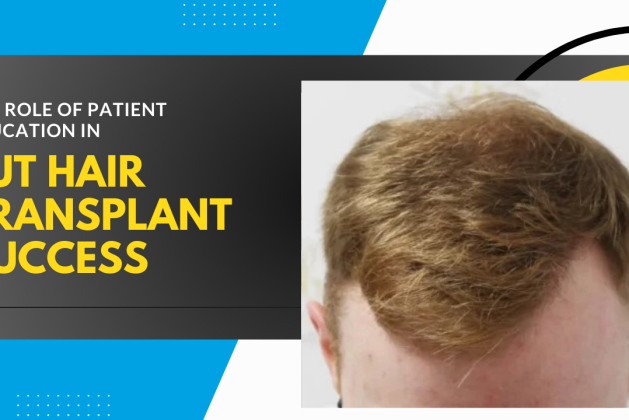Follicular Unit Transplantation (FUT) is a widely recognized hair restoration procedure that helps individuals combat hair loss. This treatment involves moving hair follicles from a donor location to balding or thinning areas, and it has grown in popularity due to its efficacy and natural appearance. However, the effectiveness of FUT hair transplant is heavily dependent on patient education. Educated patients are more likely to have reasonable expectations and be satisfied with their outcomes. This paper analyzes the important role of patient education in the efficacy of FUT hair transplant surgery.
1. Understanding FUT Hair Transplant
FUT is a hair restoration technique that involves harvesting a strip of skin containing hair follicles from a donor area, typically the back of the scalp. This strip is divided into individual follicular units and transplanted to the balding areas. Unlike Follicular Unit Extraction (FUE), which involves extracting individual follicles, FUT is characterized by its efficiency in harvesting multiple follicles at once.
Understanding how FUT differs from other hair restoration methods is crucial for patients. Knowledge about the procedure helps patients make informed decisions, ensuring they choose the best technique for their unique needs.
2. Pre-Procedure Education
What to Expect Before the Procedure
Before undergoing FUT, patients must attend consultations where their medical history will be assessed and eligibility measures discussed. During these consultations, potential candidates should ask specific questions to better understand the process and outcomes. Selecting a qualified surgeon is paramount; patients should research the surgeon’s credentials and experience to ensure they are in capable hands.
Preparing for Surgery
Preparation for FUT includes making lifestyle adjustments, such as modifying diet and medications before the procedure. Patients are often advised to avoid blood thinners and certain supplements that can increase bleeding risks. Understanding and adhering to pre-operative instructions minimizes potential difficulties and paves the way for a smoother surgery.
3. Post-Procedure Education
Immediate Recovery
Post-operative care is important for a successful FUT hair transplant. Patients will notice swelling, redness, and pain in the donor and recipient sites right after the treatment. Understanding the recovery process, including how to manage these side effects, is important for patients. Following the surgeon’s guidelines for pain management and care routines will facilitate healing.
Long-term Care
Long-term treatment after FUT is essential for attaining the best results. Patients must adhere to thorough aftercare recommendations to guarantee that their freshly transplanted hair follicles survive. This includes correct hair washing techniques, scalp care, and avoiding harmful activities like strenuous exercise or direct sunshine. Adhering to these rules improves the overall success of FUT hair transplants.
4. Role of Educational Resources
Surgeon-led Education
Clear communication from the surgeon about the FUT procedure and recovery is critical. Patients should feel empowered to ask questions and seek clarification on any aspects of the process. Open dialogue fosters a better understanding and comfort level, ultimately contributing to the success of the treatment.
Informational Materials
Brochures, videos, and online resources serve as valuable educational tools for patients considering FUT hair transplants. Reputable sources can provide insights into what to expect, recovery tips, and possible outcomes. Patients should utilize these materials to supplement their knowledge and stay informed throughout their hair restoration journey.
5. Benefits of Patient Education
Realistic Expectations
One major advantage of patient education is the setting of realistic expectations. When patients know what to expect from their FUT hair transplant in terms of results and recovery time, they are less potential to be disappointed or dissatisfied with the results. This awareness is critical for keeping a positive attitude during the rehabilitation process.
Increased Satisfaction
There is a strong correlation between well-informed patients and overall satisfaction with their hair transplant experience. When patients are knowledgeable about the process, they are more likely to appreciate the results and feel confident in their decision.
Better Compliance
Understanding the significance of post-operative care improves adherence to the surgeon’s instructions. Patients who are taught about the rationale for special aftercare requirements are more likely to adhere to them, which improves the overall outcome of the FUT hair transplant.
6. Common Myths and Misconceptions
Myths and misconceptions about FUT might cause uncertainty and concern among potential patients. For example, some people consider that FUT leaves a visible scar or that the recovery procedure is too difficult. Addressing these fallacies is critical for promoting greater understanding and encouraging people to consider FUT as a viable hair restoration method.
Conclusion
Patient education is critical for attaining excellent results with FUT hair transplants. Informed patients are more prepared to navigate the pre- and post-operative phases, which improves satisfaction and outcomes. Patients can considerably boost their probabilities of success by actively seeking information and participating in the hair restoration process. It is critical for persons considering FUT to consult with experienced professionals and use accessible educational resources. At Beverly Hills Hair Restoration, we value patient education and are dedicated to guiding people through each step of the hair restoration process.




Leave a comment